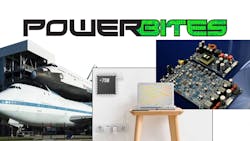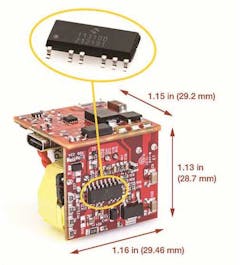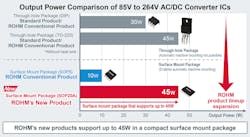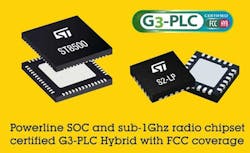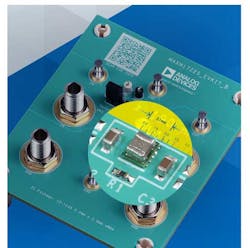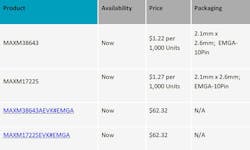This Week in PowerBites: GaN Galore, a Novel Power Topology, and an APEC Invite
This article is part of the This Week in PowerBites Series
ED's PowerBest Awards Celebrate Some of 2021's Best Power Products – and the People Behind Them
The only way to think of 2021 as a good year would be to compare it to 2020, or to reflect on the amazing things the power technology industry managed to achieve, despite the challenges the pandemic threw at us. We've created the PowerBest awards to recognize at least a few of those achievements and share our heartfelt thanks to all of the engineers, technicians, marketeers, and the other members of the global electronics community for making 2021 "a truly powerful year" in the face of so many challenges. To see what we've chosen as 14 of the year's most innovative products, visit "Electronic Design's 2021 PowerBest Awards."
New AC-DC Converter Topology Enables Smaller, Cooler-Running, Lower-Cost Designs
When I was briefed on Eggtronic's QuarEgg+ power architecture last December, I was surprised to find that the company developed a novel and very promising approach to implementing several very mature power-conversion technologies. Quasi-resonant (QR) and resonant power converters have been in use so long that I'd assumed any significant innovations, other than higher levels of integration, had already been mined out.
It was a pleasure to have that assumption challenged with a new alternative to the active-clamp-flyback (ACF) and QR topologies used in most modern switched-mode ac-dc converters. This fresh approach offers better efficiency across a wider load range (Eggtronic claims 7X), significantly reduced BOM costs, and up to a 3X improvement in power density.
Capable of delivering up to 60 W, the QuarEgg+ solution targets applications ranging from fast chargers and adapters for mobile devices and laptops to power supplies for loudspeakers and smart home assistants. It operates with zero voltage switching (ZVS) under all load conditions to give very flat light-load-to-full-load efficiency curves. Efficiencies are up to 95% at full load and up to 92% at light load.
Power consumption is further reduced thanks to the ultra-low standby power of less than 18 mW. Elimination of a high-voltage, high-side clamping MOSFET minimizes component count and improves reliability, while smooth transient response reduces electromagnetic interference (EMI) to simplify filtering requirements.
While QuarEgg+ does use integration to reduce component count, its unique architecture is responsible for the bulk of the BOM cost savings. For example, its synchronous rectification technique is more efficient and drastically reduces both EMI and the sharp voltage spikes produced by conventional switching circuits. As a result, designs based on the QuarEgg+ architecture can be implemented with lower-rated, less expensive power transistors, smaller EMI filter components, and smaller heatsinks. And for applications that require isolation, it can be implemented without a costly optocoupler using a capacitor or a very small transformer.
Eggtronic says that QuarEgg+ is the first in a series of power-conversion and power-factor-correction (PFC) architectures in the Eggtronic EcoVoltas family. All solutions in the EcoVoltas portfolio are designed to boost the performance of FET switching devices, whether they’re based on legacy silicon or wide-bandgap (WBG) materials such as gallium nitride (GaN) and silicon carbide (SiC). They also drive down no-load “vampire” power and reduce the overall BOM.
To help speed the development of ac-dc applications built on QuarEgg+ technology, Eggtronic will offer reference designs for both GaN-based and silicon-based devices with power outputs of 35, 45, and 60 W. Output options include USB PD, fixed voltage, and CC CV. Development boards, integrated power controllers, a range of proprietary magnetic components, and comprehensive technical support also will be available.
Additional information about QuarrEgg+ is available at this link. And further information about Eggtronic EcoVoltas family is available hereOne of the first applications for the new technology is the world's slimmest 50-W fast charger, recently introduced by consumer electronics manufacturer OPPO.
Updated datasheets and reliability reports are available immediately to customers and design partners under NDA.
GaN-Beater: All-Silicon 33-W 1C Charger Ref Design Delivers Low-Cost GaN-Like Performance
Silanna Semiconductor introduced a reference design (RD-23) for 33-W 1C fast charger applications based on using silicon power FETs, offering GaN-like performance at a lower cost. Based on the company’s SZ1131 CO2 Smart Power active-clamp flyback (ACF) controller technology, Silanna says that the design matches or exceeds that of commercially available 30-W GaN-based chargers at a cost more readily associated with conventional silicon designs.
The design includes everything an engineer will need to prototype and develop a fully functional charger with low operational and no-load/standby power consumption and minimum component count, BOM cost, and size. Providing an (uncased) power density of 22W/in.3, the RD-23 operates with a peak efficiency of over 92% and a no-load power consumption (@ 230 Vac) below 20 mW. Efficiency is flat across the universal input (90-265 V ac) range. The reference design is fully production-ready as it exceeds conducted and radiated EMI requirements by more than 6-dB margins.
To further speed designs based on the RD-23, all PCB Gerber files and production files are available on request.
RD-23 uses Silanna's SZ1131 ACF controller IC, which is rated for 65 W for universal input and above 100 W with PFC-supported applications. It integrates an adaptive digital PWM controller, ultra-high-voltage (UHV) active-clamp FET, active-clamp gate driver, and startup regulator into a single compact device.
The SZ1131 operates at frequencies of up to 146 kHz and provides the ease-of-design of a simple flyback controller with all the benefits of an ACF design. This includes recycling the leakage inductance energy of the flyback transformer and limiting the primary FET drain voltage spike during turnoff events. Employing Silanna’s OptiMode digital control architecture, the SZ1131 adjusts the device’s mode of operation on a cycle-by-cycle basis to maintain high efficiency, low EMI, fast dynamic load regulation, and other key power-supply parameters in response to varying line voltage and load.
Supplied in a 16-pin SOIC package, the SZ1131 offers protection against overtemperature, overvoltage, overcurrent, overpower, and short-circuit conditions, as well as transformer core saturation fault, without the need for additional external components.
Further Information is available at https://powerdensity.com/reference-design.
Compact Surface-Mount 45-W Output AC-DC Converter ICs
Equipped with integrated high-voltage superjunction MOSFET flyback converter ICs, ROHM Semiconductor's new BM2P06xMF-Z series of ac-dc flyback converter ICs maximize performance, reduce system cost, and increase reliability for industrial and consumer power-supply solutions.
The devices provide simple, efficient solutions for the auxiliary power supplies and switch-mode power supplies used in industrial drives, as well as home appliances including air conditioners, white goods, and factory automation equipment. Featuring an integrated 730-V breakdown MOSFET, they require no additional heatsinks, discharge resistors, or capacitors, enabling designers to shorten design time, simplify circuitry, reduce cost, and increase reliability.
The BM2P060MF-Z, BM2P061MF-Z, and BM2P063MF-Z were created for products that need to support the wide range of ac voltages around the world (85-264 V ac), as well as comply with international requirements such as the U.S.'s ENERGY STAR efficiency standard and the IEC 62368 safety standard.
The BM2P06xMF-Z devices' advanced surface-mount package reduces factory assembly costs while still delivering up to 45 W of power. This is possible due to the original low-loss superjunction MOSFET and optimized PWM control circuitry. The converters also enjoy reduced standby power by (up to 90%) and up to 75% fewer external components than conventional designs for greater power savings and higher reliability. Typical applications include:
- Consumer electronics such as air conditioners, appliances, monitors, and hair dryers
- Industrial equipment including inverters, ac servos, routers, and office automation devices
- Suitable for ac-dc converters with up to 45W output in consumer and industrial applications
Pricing for the devices is $2.13/unit (samples, excluding tax). Samples are available now, with mass production scheduled for this month.
G3-PLC Hybrid Smart Meter Chipset Features Expanded Connectivity
STMicroelectronics' ST8500 G3-PLC (Power-Line Communication) hybrid communication chipset now offers extended certification to cover the U.S. FCC band plan from 10 to 490 kHz and the CENELEC-A 9-to-95k-Hz European band. The move enables higher data rates, enhances design flexibility, and eases end-product approval in accordance with specific national regulations.
With the G3-PLC Hybrid profile, smart, connected devices can select powerline or wireless communication autonomously, and change dynamically to ensure reliable connectivity and optimum performance. ST’s ST8500 G3-PLC Hybrid chipset comprises the ST8500 protocol controller system-on-chip (SoC), which supports RF mesh for reliable long-range wireless communication, the STLD1 PLC line driver, and the S2-LP low-power IEEE 802.15.4 RF transceiver.
In addition to smart electricity meters, the chipset can provide smart connectivity to gas and water smart meters, environmental monitors, lighting controllers, and remote sensors in contexts such as smart cities, smart infrastructure, smart buildings, and smart factories.
To accelerate development of smart, connected nodes that leverage the G3-PLC Hybrid profile for dual PLC and RF connectivity, ST created a support ecosystem that includes the EVLKST8500GH868 and EVLKST8500GH915 development kits, which work respectively at 868 MHz and 915 MHz. Each kit contains a development board to build one node that combines the ST8500 and S2-LP chipset with an STM32G070RB host microcontroller, and it allows custom functions to be added using Nucleo expansion boards.
The associated STSW-ST8500GH software framework includes ST’s G3-PLC Hybrid communication stack, Protocol Engine and Real-Time Engine modem firmware images, and a framework based on ST’s popular STM32CubeMX tool. The latter helps developers quickly develop and integrate their application firmware.
The EVLKST8500GH868 and EVLKST8500GH915 kits are available now from ST’s e-store and distributors, starting from $294.00. Please contact your local ST sales office for chipset pricing options and sample requests. For more information, go to www.st.com/powerline.
Compact, Ultra-Low-IQ Power Modules Extend Battery Life in Space-Constrained Apps
Analog Devices' compact nanoPower modules feature built-in inductors and extremely low standby power to help prolong battery life and reduce size in space-constrained IoT devices. These latest members of ADI's Essential Analog family of efficient power ICs feature the lowest IQ compared to competitive solutions and deliver more battery life, according to the company. By integrating a preselected inductor, these micro system-level IC modules (µSLICs) also accelerate time to market and are up to 37% smaller than a standalone IC plus external inductor. Applications include space-constrained consumer products, wearables, medical drug delivery, sensors, IoT devices, as well as wired, wireless, and industrial products.
The MAXM38643 features a 1.8- to 5.5-V input, 330-nA quiescent current (IQ), 600-mA buck module. The MAXM17225 has a 0.4- to 5.5-V input, 300-nA IQ, 1-A boost module with True Shutdown.
Both the MAXM38643 and MAXM17225 consume an order of magnitude less quiescent current (one-tenth and one-twentieth, respectively) than competitive solutions with similar output currents. In addition, the MAXM38643 and MAXM17225 have peak efficiencies of 96% and 95% respectively.
Pricing and Availability
Details about ADI’s nanoPower technology, including a video that includes hands-on demonstrations of the new modules, can be found at https://bit.ly/ADI_nanoPower
Additional details about ADI’s Power Modules solutions can be found at https://bit.ly/ADI_Power_Modules
Compact GaN-Based Class-D Audio Amp Reference Design Puts 200 W/Channel
GaN Systems' GeN2 amplifier and companion power-supply reference design offers even better sound quality, thermal performance, size, and cost attributes over its first-generation design, which was released last year. The evaluation kit includes a two-channel, 200-W/channel (8 Ω) Class-D audio amplifier with 96% efficiency and companion 400-W continuous, 550-W peak power audio-grade SMPS. It enables audio design engineers to create premium audio products more quickly.
With the GeN2 reference design, design engineers can develop a heatsink-less, self-powered (from ac line input) design with no external dc supplies required and smaller-size boards due to a high level of controller and DSP integration. Its advanced control techniques enable it to deliver high efficiency across a wide load.
Improvements include a 20% overall size reduction in the power supply with a higher level of protection against lower impedance loads to the amplifier. Enhanced thermal management enables it to run at 10°C at an equivalent load. In addition, GeN2 features a reduced BOM cost. On top of that, the solution highlights an easy plug-and-play design with features such as multi-audio signal inputs, bridge-tied load output, and open-loop/closed-loop toggling.
For even higher-power applications, the design can be quickly scaled upward through changes to its magnetics and GaN transistors.
You can download the design guide now. You may also visit www.gansystems.com and sales channel partners to request more information or purchase this evaluation kit.
Meet Up with Editor Lee Goldberg at APEC 2022 in March
During the days of the Wild West, Texas had a reputation for being home to some of the nation's richest cattle barons and shrewdest gamblers. So it's no surprise that the city of Houston is betting that the worst of the latest COVID outbreak will be behind us by March 20-24, 2022 when the Applied Power Electronics Conference's (APEC) returns to an in-person format, following two years of COVID-induced exile in cyberspace. Held at Houston's George R. Brown Convention Center, APEC will treat its attendees to a jam-packed five-day program of technical sessions, industry sessions, seminars, exhibits, and other industry events.
Likewise, I'm planning (COVID permitting) on making APEC 2022 my first real-world event since the start of the pandemic. In addition to providing from-the-floor show coverage and meeting with many of the power community's leading manufacturers, I'm hoping to get some (socially distanced) face time with some of the industry's best and brightest engineers, i.e., Electronic Design's readers.
After two years of isolation, it will be great to see your shining faces again while we swap industry gossip and trade insights about where power technology is heading. As with my previous meetups, I also hope to get your feedback about how I can improve my coverage to keep you more informed, educated, and entertained.
Depending on what the pandemic conditions are like in Houston, I'll either find a place where we can meet up as a group or make arrangements to meet up with you individually. In both cases, we'll be observing social distancing and I'll be providing coffee and other refreshments if possible.
I'll provide details of when, where, and how the meetup will happen as soon as I know more. Meanwhile, you can get a preview of the program and other details of this event in the feature story "APEC 2022 Returns to the Real World after Two Years in Cyberspace,” which was originally published here on December 21, 2021.
Read more articles in the This Week in PowerBites Series
